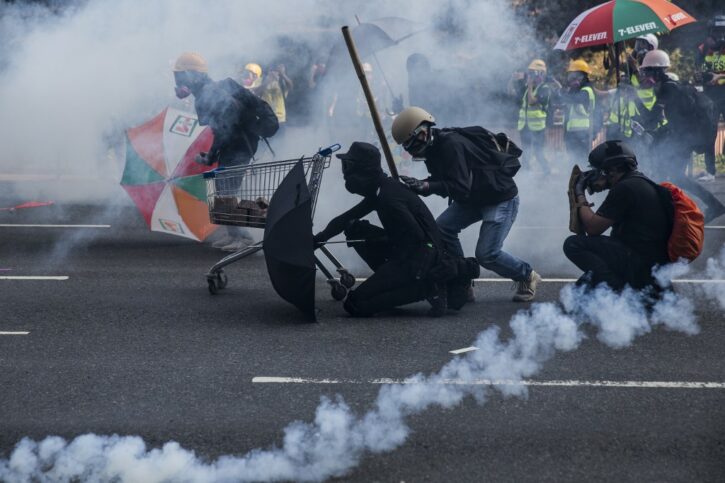
Protesters set fire to the entrance of Hong Kong's Polytechnic University early Monday in a last-ditch attempt to stop riot police from entering, as the siege of the heavily fortified campus entered its second day.
The flames followed a night of violence as students hurled petrol bombs at Hong Kong police, who deployed water cannons and warned that if given no other choice they would use “live rounds.”
Around 8 a.m. on Monday, dozens of protesters attempted to leave the university through the main entrance as police fired rounds of tear gas. CNN witnessed multiple protesters being led away by police on the roads leading from the campus.
The Hong Kong police force has yet to disclose how many people have been arrested in the almost 24-hour siege, and there are no clear numbers for those who have been injured.
As of Monday morning, several hundred protesters were thought to remain barricaded inside the university's main building.
Over the weekend, the site had been used to stockpile weapons, including bows and arrows, catapults and petrol bombs, though it was unclear how many weapons remained.
Earlier Monday morning, the president of the university's student union said in a statement posted to Facebook that “thousands” of students were still on the campus, some of whom were injured. “We have tried to communicate with school authorities, but we have not received any reply after more than two hours,” the president Derek Liu said.
Liu accused riot police of storming the collegiate area of the university and carrying out “a massive arrest” of protesters. In a statement, police said claims that police “raided” the university were “totally false.”
Images from the ground on Monday morning showed scenes of devastation around the campus, with debris and trash littering nearby streets.
Schools are closed across the city on Monday, extending a disruption that began last week. In a statement on Sunday, the government said the closures were “for the sake of safety.”
University ‘widely damaged’
Polytechnic University is one of a number of university campuses used in the past week as a rallying point for Hong Kong's anti-government protest movement. But unlike other campuses, such as the Chinese University of Hong Kong, the Polytechnic University sits in the centre of the city, close to a number of major roads including a cross-harbour tunnel.
It's in the Hung Hom district, just across Victoria Harbor from Hong Kong Island, and is also less than 164 feet (50 meters) from a Chinese People's Liberation Army (PLA) base.
Police attempted to clear the roads around Polytechnic University on Saturday night but were forced to back down after protesters started fires on the street and threw petrol bombs and bricks using catapults. Their hold on the high ground made it difficult for police vehicles to advance.
Earlier Sunday, a police media liaison officer was hit in the leg with an arrow during the skirmish and police fired water cannons at protesters in the streets.
“They showed total disregard for the safety of everyone at scene,” police said in a statement Sunday, confirming they tried to disperse the group using tear gas.
A 23-year-old protester and Polytechnic University alumnus told CNN on Sunday he didn't have a plan and was just waiting to see how the police would react. “If we don't come out, no one will come out and protect our freedoms. Polytechnic University is my home,” he said.
Protesters on Sunday were using catapults to launch bricks and other hard objects at police lines from the university's balconies.
“Such attacks pose a grave threat to the safety of police officers, reporters and first aiders at the scene,” said police in a statement, accusing protesters of firing petrol bombs and metal balls at their lines.
On Sunday, the management of Hong Kong Polytechnic University issued a statement saying “dangerous chemicals” had been stolen from laboratories and condemned the protesters’ “illegal acts and violence” in the campus which has, they say, “been widely damaged.”
“We understand that students care about the current social situation, however, they must be calm and rational when fighting for anything,” the statement said. “Resorting to violence or other radical acts will not help solve the problem.”
In a fiercely worded statement, the police labelled the group holding the university “rioters,” a loaded term in Hong Kong's protests that could result in a heavy prison sentence.
In a statement Sunday evening, the Hong Kong Professional Teachers’ Union and the university's Staff Association said they were “very worried” about the safety of students and bystanders.
“We call on both sides to exercise restraint and avoid the use of deadly weapons. The current stalemate is caused by a series of government decision-making mistakes and should be resolved responsibly,” the statement said.
Six months of chaos
The protests in Hong Kong have now been raging for almost six months after they began in June over a controversial China extradition bill, which sparked huge marches across the city.
When the government suspended but didn't withdraw the bill, the movement's focus quickly expanded to focus on complaints of police brutality and wider calls for democracy.
The protests took a turn in early November after the protest-related death of a 22-year-old student, the first since the demonstrations began. Protesters began to fortify university campuses across the city, holding off police with weapons ranging from bows and arrows and petrol bombs.
With both the government and protesters refusing to back down, there is no immediate end in sight to the Hong Kong demonstrations.
Showing his dissatisfaction with the situation, Chinese President Xi Jinping made rare public comments on the demonstrations Thursday.
He said that “radical” protesters had trampled the city's rule of law and that “stopping the violence and restoring order” was Hong Kong's most “urgent task.”
It came just hours before a 70-year-old man, who was struck by a brick during clashes between protesters and their opponents, died of his injuries. Police blamed protesters for throwing the object that killed him.
For the first time since the start of the demonstrations in June, the PLA hit the streets of Hong Kong on Saturday, but only to clear up barricades and debris.
Even that incursion was enough to spur pro-democracy lawmakers in Hong Kong to push for an explanation from the city's government.
Chinese soldiers’ efforts to clear roadblocks outside their barracks in Kowloon Tong was “purely a voluntary community activity initiated by themselves,” the Hong Kong special administrative region government said in a statement to CNN.
CNN's Eric Cheung, Maisy Mok, Rebecca Wright, Sandi Sidhu and Brad Lendon contributed to this report.




